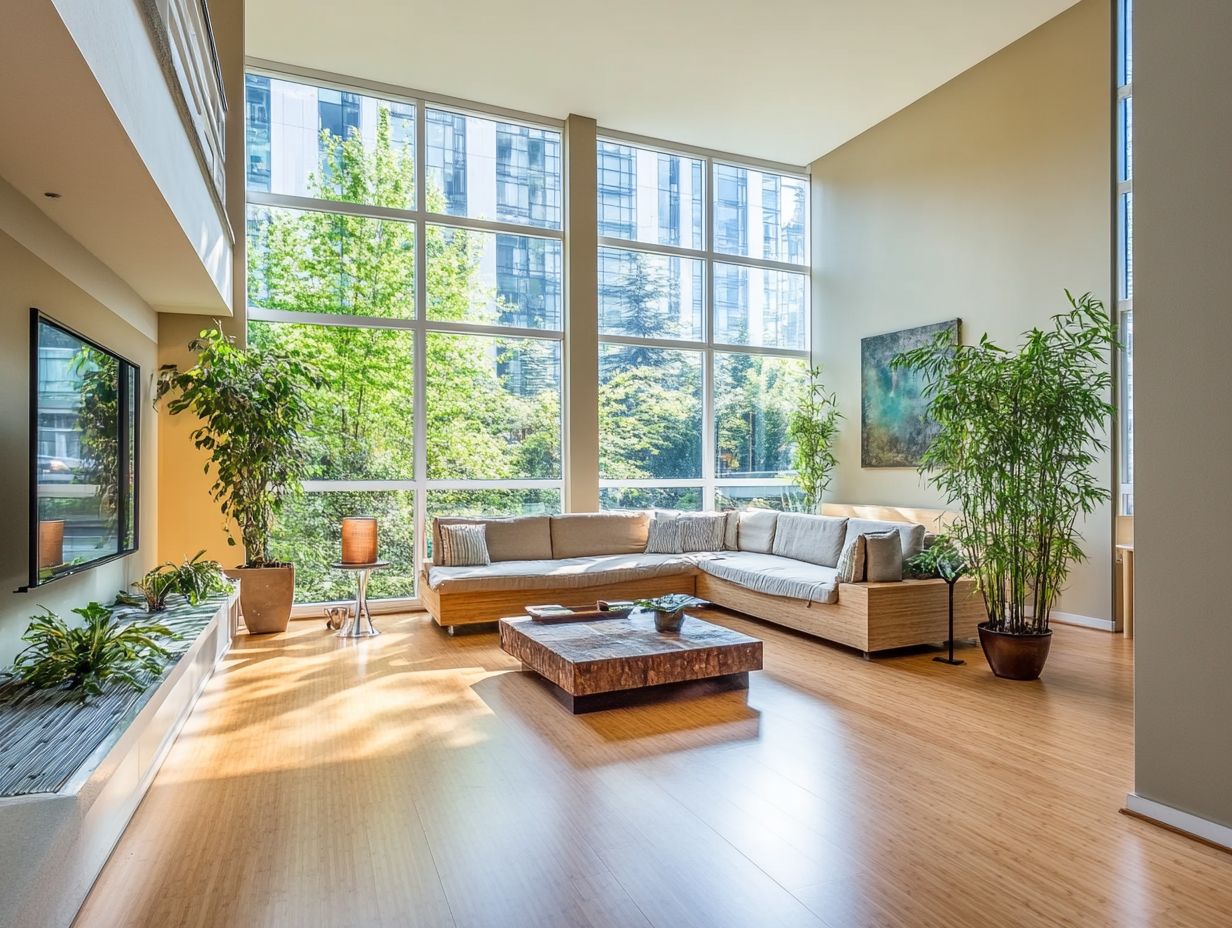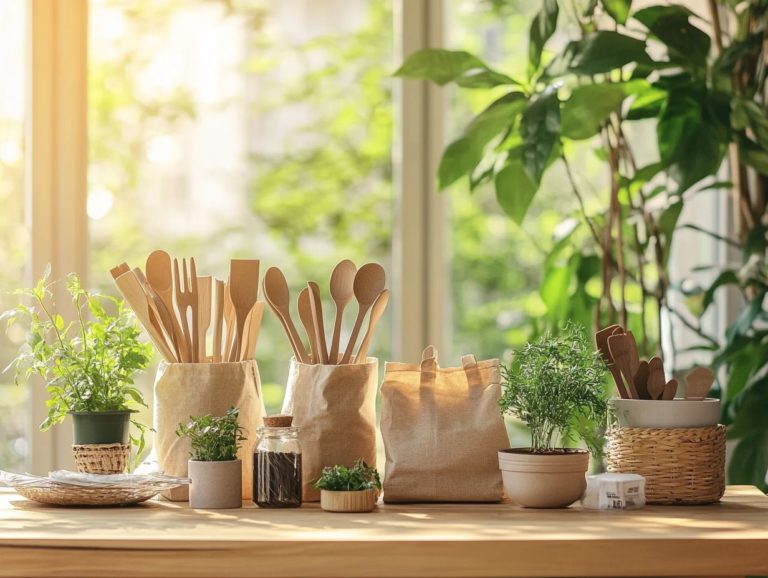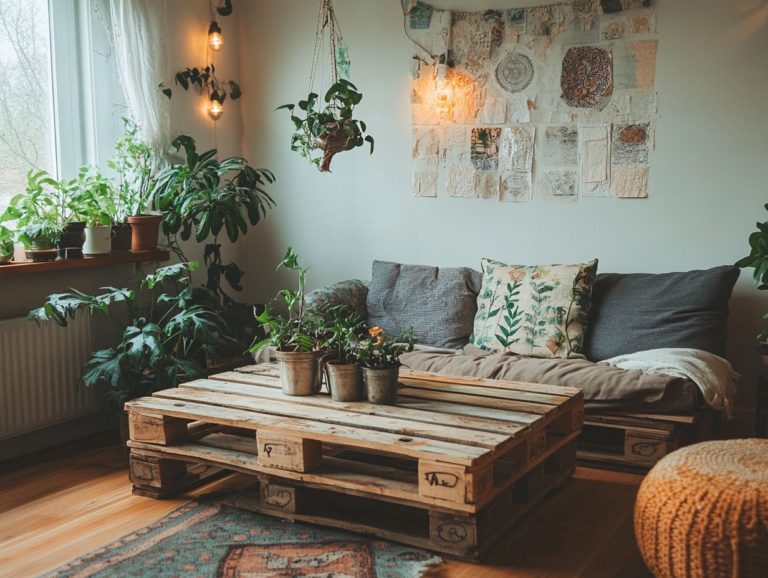Eco-Friendly Materials for Modern Homes
In today s world, the drive for sustainability reshapes how you perceive your living spaces. Eco-friendly materials present a multitude of benefits, from minimizing your carbon footprint to improving indoor air quality.
This article delves into the diverse types of eco-friendly materials available, including recycled, sustainable, and natural options, while emphasizing their environmental and health advantages. You ll find practical tips for seamlessly incorporating these materials into your home design, along with insights into their cost and maintenance considerations. Join the movement toward sustainability today and embark on a journey toward creating a healthier, more sustainable living environment.
Contents
- Key Takeaways:
- Benefits of Using Eco-Friendly Materials in Modern Homes
- Types of Eco-Friendly Materials
- Incorporating Eco-Friendly Materials into Home Design and Construction
- Cost and Maintenance Considerations
- Frequently Asked Questions
- What are eco-friendly materials for modern homes?
- Why should I use eco-friendly materials for my modern home?
- What are some examples of eco-friendly materials for modern homes?
- Are eco-friendly materials more expensive than traditional materials?
- Can I still achieve a modern and stylish look with eco-friendly materials?
- How can I incorporate eco-friendly materials into my existing home?
Key Takeaways:

- Choose eco-friendly materials for a healthier home.
- Explore various eco-friendly options, including recycled, sustainable, and natural materials.
- Incorporating eco-friendly materials into home design and construction can be achieved through careful planning and creative ideas, with considerations for initial cost, long-term savings, and maintenance.
What are Eco-Friendly Materials?
Eco-friendly materials are your go-to choice if you want to make a minimal impact on the environment. They focus on sustainability, recyclability, and energy efficiency, making them perfect for modern construction and home design.
Think along the lines of recycled steel, sustainable wood, and natural insulation options like cork and sheep’s wool. By using these materials, you can significantly reduce carbon emissions and energy consumption throughout a building’s lifecycle. Prioritizing them allows you to create structures that align with eco-friendly design principles, ultimately benefiting green architecture and contributing to a healthier planet.
These choices don t just cut energy costs; they also play a crucial role in reducing waste by minimizing contributions to landfills. Take bamboo, for example. It s a rapidly renewable resource that grows back much faster than traditional hardwoods, ensuring a sustainable supply. Recycled glass also shines, transforming into stunning countertops and tiles that blend aesthetic appeal with environmental responsibility.
By embracing these eco-friendly alternatives, you can foster a lifestyle that prioritizes the planet’s well-being while creating durable and stylish living spaces. This approach paves the way for a construction industry that values sustainability and health, reimagining what it means to build responsibly.
Benefits of Using Eco-Friendly Materials in Modern Homes
Incorporating eco-friendly materials into your modern home offers a multitude of advantages, from enhanced energy efficiency to improved indoor air quality and adherence to standards for green building. By embracing innovative materials like plant-based foam and mycelium insulation, you can markedly decrease energy consumption and carbon emissions. For more insights, explore the best sustainable material brands for homes, paving the way for long-term savings and a healthier living environment.
Adding eco-friendly features such as green roofs and solar panels not only fosters a sustainable community but also resonates with the principles of biophilic design, creating a harmonious connection between your living space and the natural world.
Environmental Benefits
Discover how eco-friendly materials can transform the environment! The environmental benefits of using these materials in construction are nothing short of transformative, significantly reducing carbon emissions and promoting waste reduction throughout the building process.
By integrating technologies like solar panels and energy-efficient HVAC systems, you can further decrease reliance on non-renewable energy sources, leading to a remarkable reduction in greenhouse gas emissions. Practices such as rainwater harvesting and greywater recycling not only conserve water a vital resource but also minimize runoff and its associated pollution.
When you choose projects that utilize reclaimed wood or bamboo, you’re not just helping to minimize deforestation; you’re also adding unique aesthetic qualities that prove sustainability can be visually striking. Ultimately, embracing these eco-friendly materials and technologies allows you to foster a holistic approach to construction that prioritizes both environmental health and the well-being of the community.
Health Benefits
The health benefits of using eco-friendly materials in construction are substantial, especially when it comes to enhancing indoor air quality and creating healthier living spaces. Imagine materials like mycelium insulation and air-purifying walls working to reduce toxins and allergens. These advancements contribute significantly to your overall well-being.
By championing natural insulation and sustainable materials, builders can create modern homes that meet today’s needs while protecting our planet! For example, opting for low-VOC (harmful chemicals that can pollute indoor air) paints can significantly cut down on harmful chemicals floating around in the air. Additionally, using sustainable materials, like bamboo flooring, offers a durable alternative to traditional materials, typically releasing fewer pollutants.
By incorporating recycled or reclaimed materials, you effectively minimize the carbon footprint of the construction process. Through these thoughtful choices, builders enhance the aesthetic appeal of homes while ensuring the spaces resonate with health and sustainability, ultimately fostering a greater sense of well-being for everyone who lives there.
Types of Eco-Friendly Materials

Eco-friendly materials can be classified into three principal categories: recycled materials, sustainable materials, and natural materials, each presenting distinct advantages for your construction projects.
Recycled materials, such as recycled plastic and reclaimed wood, not only minimize waste but also deliver durable building supplies. Sustainable materials, like bamboo and straw bales, enhance energy efficiency in your designs while offering renewable choices.
Lastly, natural materials, including clay bricks and sheep’s wool, provide robust structural integrity and exceptional insulation properties, contributing significantly to energy-saving solutions.
Recycled Materials
Recycled materials are essential in sustainable construction, as they help you divert waste from landfills and lessen the demand for new resources. Utilizing materials like recycled steel and recycled plastic not only conserves energy but also offers you durable and versatile building options.
Take recycled steel, for example. It’s celebrated for its high strength-to-weight ratio (meaning it s strong yet lightweight), making it a superb choice for structural applications. On the other hand, recycled plastic provides a lightweight and effective alternative for insulation and cladding.
Consider innovative materials like newspaperwood, which combines recycled paper fibers with adhesive to create aesthetically pleasing wood alternatives. Similarly, AshCrete, which incorporates recycled ash from power plants, not only reduces carbon emissions but also enhances the strength of concrete.
Then there’s Ferrock, which transforms recycled materials into an eco-friendly alternative to traditional concrete. This highlights the vast potential for waste reduction in construction projects and reinforces the significant impact sustainable practices can have on the environment.
Sustainable Materials
Sustainable materials are crucial for constructing homes that not only minimize environmental impact but also enhance energy efficiency and durability.
By opting for these materials, you actively contribute to a healthier planet, reducing reliance on fossil fuels and supporting a circular economy. Take straw bales, for example they’re not just budget-friendly; they offer exceptional insulation, which significantly reduces your heating and cooling demands, boosting energy efficiency.
Similarly, rammed earth walls utilize natural soil and possess remarkable thermal mass, helping to maintain a comfortable temperature throughout the seasons. Incorporating recycled materials like metal and glass can divert waste from landfills, providing additional benefits for both the environment and your construction costs.
By choosing these innovative sustainable options, you have the opportunity to create homes that are not only visually stunning but also environmentally responsible. Act now to help create a healthier future with sustainable building practices!
Natural Materials
Natural materials are essential to eco-friendly construction, offering a wealth of benefits that range from thermal efficiency to aesthetic charm. Think of clay brick and timbercrete, which are not only lauded for their structural integrity but also for their sustainability.
Insulation options like sheep’s wool and cork enhance indoor air quality and energy efficiency, making your spaces more comfortable. Straw bales emerge as a creative building alternative, promoting waste reduction while highlighting the potential of natural materials in contemporary architecture.
Integrating these eco-friendly materials into your building practices is crucial. They significantly help reduce the construction industry’s carbon footprint. Choosing local resources supports your community and reduces transport emissions. These materials often have a lower embodied energy compared to traditional ones, resulting in a more sustainable lifecycle.
Consider the innovative use of bamboo, which offers impressive tensile strength and rapid renewability. This further underscores the myriad possibilities for environmentally conscious design.
As society increasingly embraces greener choices, the role of natural materials in architecture will only continue to expand, paving the way for a more sustainable future.
Incorporating Eco-Friendly Materials into Home Design and Construction
Incorporating eco-friendly materials into your home design and construction is essential for cultivating sustainable living environments that resonate with the principles of sustainable home materials and green architecture.
By embracing innovative materials and eco-friendly technologies, you have the opportunity to enhance energy efficiency and significantly reduce your home’s carbon footprint. Incorporating top decorative items for eco-conscious homes, whether you choose sustainable wood, integrate solar panels, or utilize geothermal heating, opens countless avenues to create spaces that are not only functional but also environmentally responsible.
Tips and Ideas for Using Eco-Friendly Materials

When exploring eco-friendly materials for your home, consider several tips and ideas to strike the perfect balance between sustainability and functionality. Incorporate building alternatives like green roofs and solar panels; they boost energy efficiency and enhance your home’s visual appeal.
Opt for energy-saving materials and sustainable design practices to significantly reduce your carbon footprint and create a healthier living environment. As a homeowner or builder, delve into options such as reclaimed wood, recycled metal, and low-VOC paints. These choices minimize environmental impact while stylishly transforming your spaces.
Consulting with certified green architects or interior designers can provide valuable insights into the latest trends and technologies. Actively sourcing locally-produced materials supports the economy and cuts down on transportation emissions.
By considering life cycle assessments that include durability and maintenance needs, you can make informed decisions that prioritize long-term sustainability without sacrificing aesthetics or quality.
Cost and Maintenance Considerations
Take a moment to evaluate the initial expenses; the savings could surprise you! When evaluating the cost and maintenance aspects of eco-friendly materials, consider the initial expenses in relation to potential long-term savings.
Although some sustainable materials may come with a higher upfront price tag, their durability and energy efficiency frequently result in significant savings on energy bills and maintenance over time.
Grasping the balance between your initial investment and the future benefits is essential for making well-informed decisions about integrating eco-friendly materials into your construction projects.
Explore eco-friendly options today to make a difference!
Initial Cost vs. Long-Term Savings
When weighing the initial cost against the long-term savings of eco-friendly materials, it’s crucial to understand how energy-efficient materials can lead to significant cost reductions over time.
Many individuals and businesses often overlook the substantial financial advantages of choosing sustainable options. For example, while insulated concrete forms and high-efficiency windows may have a higher upfront price tag, they substantially enhance thermal performance the ability to maintain comfortable temperatures ultimately slashing heating and cooling costs.
Incorporating solar panels can further reduce your utility expenses, creating a more resilient financial framework. In this scenario, the relationship between initial investments and long-term savings goes beyond just being good for the environment; it becomes a wise financial strategy that aligns with your budget and sustainability objectives!
Maintenance and Durability of Eco-Friendly Materials
When building sustainable homes, the maintenance and durability of eco-friendly materials are essential factors to consider. Options like reclaimed wood and bamboo not only enhance the aesthetic appeal of your space but also boast remarkable durability and require minimal upkeep over time. By choosing long-lasting materials, you’ll enjoy amazing environmental benefits while having the peace of mind that comes with lower maintenance demands.
Take, for example, composite decking made from recycled plastics and wood fibers. It resists fading, staining, and splintering, significantly reducing the need for annual maintenance. Similarly, rammed earth and straw bale construction provide impressive thermal mass and insulation, leading to reduced energy consumption while standing the test of time with minimal wear.
Recycled metal roofing is incredibly durable, offering longevity and requiring very little maintenance. This makes it an excellent choice for eco-conscious homeowners seeking both resilience and aesthetic charm in their building projects.
Frequently Asked Questions
What are eco-friendly materials for modern homes?

Eco-friendly materials for modern homes are sustainably sourced, non-toxic, and have a minimal negative impact on the environment. Understanding why sustainable materials are essential for green homes reveals that they are often made from renewable resources and can be recycled or reused.
Why should I use eco-friendly materials for my modern home?
Using eco-friendly materials for your modern home can have numerous benefits, including reducing your carbon footprint, improving indoor air quality, and promoting a healthier environment. For more insights, check out this guide on how to choose sustainable materials for your home!
What are some examples of eco-friendly materials for modern homes?
Some examples of eco-friendly materials for modern homes include bamboo, reclaimed wood, recycled glass, natural stone, and low-VOC paints. For a deeper understanding of how these materials contribute to an eco-friendly living space, check out sustainable materials: the key to an eco-friendly home. Other materials such as cork, hemp, and recycled plastic are also gaining popularity in sustainable home building.
Are eco-friendly materials more expensive than traditional materials?
In some cases, eco-friendly materials may be more expensive than traditional materials. However, in the long run, they can save you money through lower energy costs, reduced maintenance, and a longer lifespan. Additionally, the cost of eco-friendly materials is gradually decreasing as they become more widely used.
Can I still achieve a modern and stylish look with eco-friendly materials?
Yes, absolutely! There are many modern and stylish eco-friendly materials available today, and incorporating them into your home design can create a unique and trendy look. To further enhance your design, consider making eco-friendly choices with materials and mixing them with traditional options to achieve your desired aesthetic!
How can I incorporate eco-friendly materials into my existing home?
There are various ways to incorporate eco-friendly materials into your existing home, such as switching to LED light bulbs, using low-VOC paint, and investing in energy-efficient appliances. You can also consider incorporating eco-friendly materials during renovations or upgrades, such as using sustainable flooring options or installing solar panels.
Consider taking action today to make your home more eco-friendly! Explore your options for sustainable renovations and learn more about the benefits of green living!






